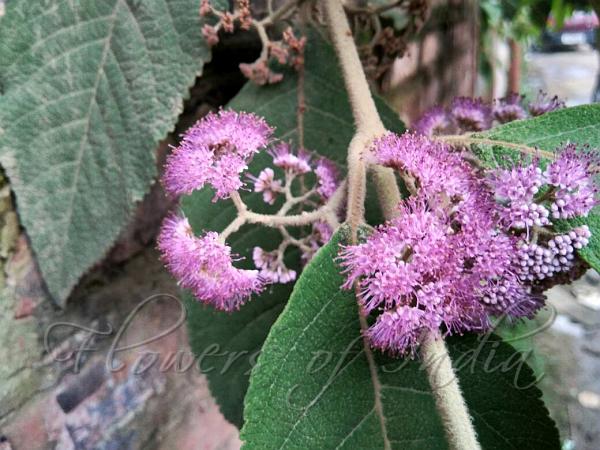|
| Large-Leaf Beauty Berry |
|

|

|
|
|
|
Photo: |
Botanical name: Callicarpa macrophylla Family: Verbenaceae (Verbena family)
Synonyms: Callicarpa incana, Callicarpa cana, Callicarpa dunniana
Synonyms: Callicarpa incana, Callicarpa cana, Callicarpa dunniana
Large-Leaf Beauty Berry is an erect, evergreen
shrub, 1-2 m tall, densely woolly on young branches, lower surface of
leaves, leaf-stalks and flower-cluster-stalks. Leaves are opposite,
10-25 cm long, 5-7.5 cm broad, ovate-lanceshaped to oblong-lanceshaped,
tapering, rounded toothed, dark-green and becoming hairless above, pale
or dull and densely woolly below; leaf-stalk 1.0-1.5 cm long. Flowers
are borne in dense, dichotomously branched cymes in leaf-axils, up to 5
cm long, including 1 2.5 cm long flower-cluster-stalks. Flowers are
about 4 mm across, pink or reddish. Calyx is about 1.7 mm long,
bell-shaped, minutely 4-toothed, densely velvet-hairy. Flowers are
about 2.5 mm long, with tube about as long as the calyx; limb somewhat
2-lipped, with 4, short lobes. Stamens are 4, prominently protruding
out; anthers about 0.8 mm long, ovate-oblong. Fruit is spherical, 2-3
mm in diameter, whitish, with a hard endocarp, usually breaking into
four, 1-seeded pyrenes. Large-Leaf Beauty Berry is found in the
Himalaya, from Kashmir to Bhutan, India, Burma, S. China, Indo-China,
at altitudes of 300-1500 m. It is also found in the evergreen forests
of Western Ghats.
Medicinal uses: Leaves are warmed and applied
to rheumatic joints. Smoked to relieve headache. Seed-paste used in
stomatitis. Wood paste used in mouth and tongue sores. Seeds and roots
are employed as stomachic. Bark is used in rheumatism and diseases of
genitourinary tract. The Ayurvedic Pharmacopoeia of India indicated the
use of the fruit in emesis and giddiness.
Leaves are warmed and applied
to rheumatic joints. Smoked to relieve headache. Seed-paste used in
stomatitis. Wood paste used in mouth and tongue sores. Seeds and roots
are employed as stomachic. Bark is used in rheumatism and diseases of
genitourinary tract. The Ayurvedic Pharmacopoeia of India indicated the
use of the fruit in emesis and giddiness.
Medicinal uses:
 Leaves are warmed and applied
to rheumatic joints. Smoked to relieve headache. Seed-paste used in
stomatitis. Wood paste used in mouth and tongue sores. Seeds and roots
are employed as stomachic. Bark is used in rheumatism and diseases of
genitourinary tract. The Ayurvedic Pharmacopoeia of India indicated the
use of the fruit in emesis and giddiness.
Leaves are warmed and applied
to rheumatic joints. Smoked to relieve headache. Seed-paste used in
stomatitis. Wood paste used in mouth and tongue sores. Seeds and roots
are employed as stomachic. Bark is used in rheumatism and diseases of
genitourinary tract. The Ayurvedic Pharmacopoeia of India indicated the
use of the fruit in emesis and giddiness. | Identification credit: Tabish | Photographed in Imphal, Manipur. |
• Is this flower misidentified? If yes,